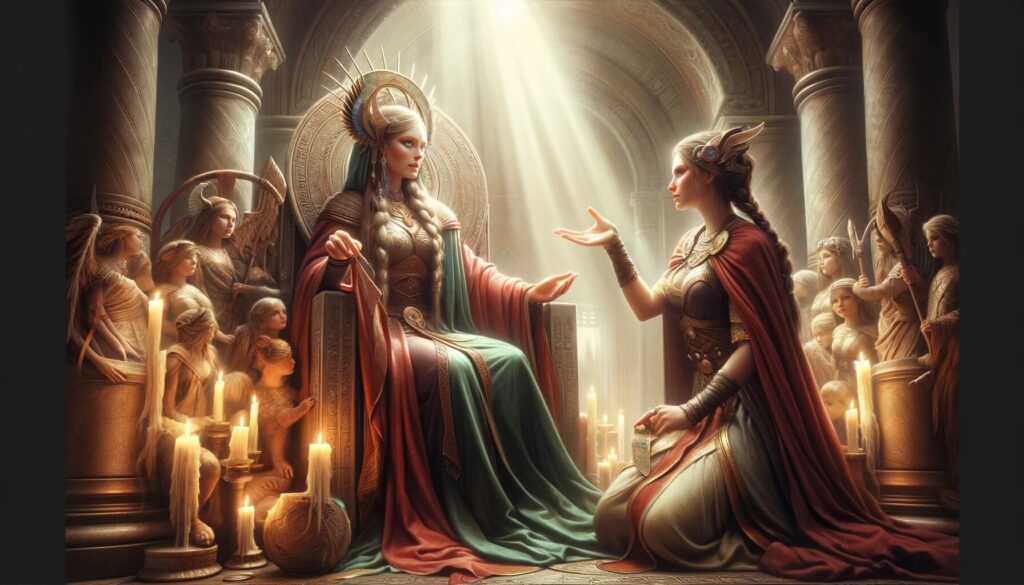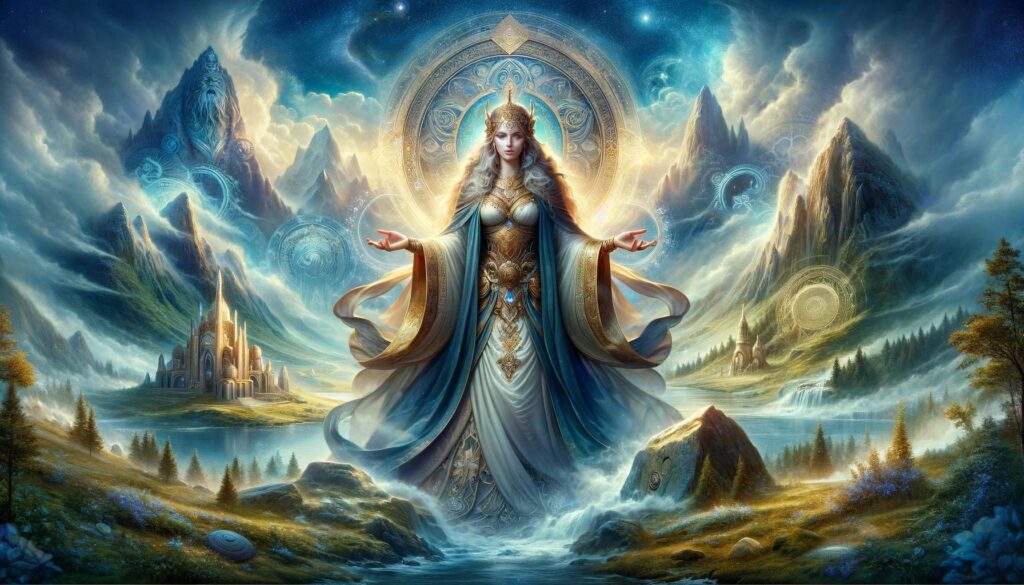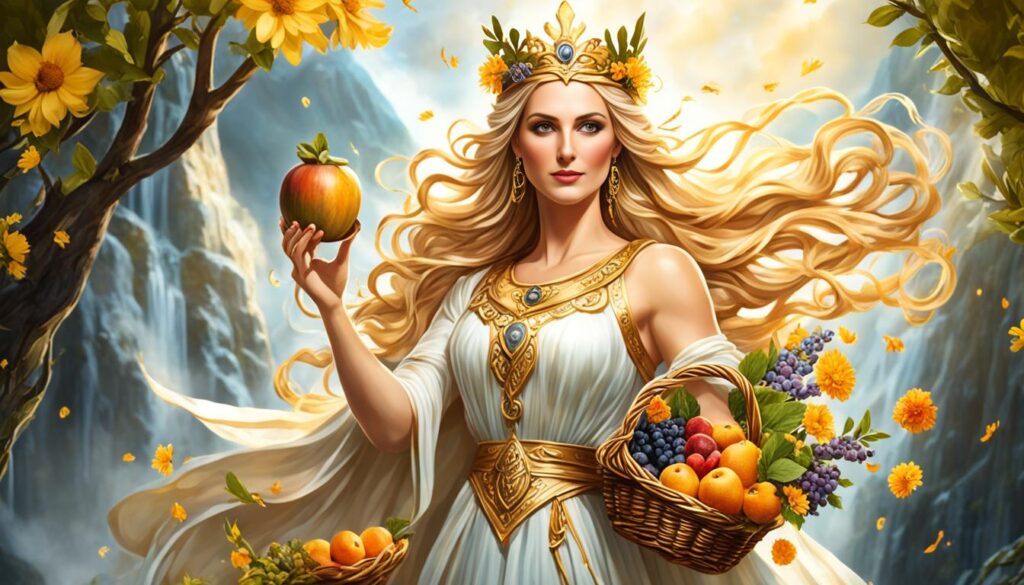Aesir Goddesses, Frigg, Norse Goddesses, Norse Mythology, Tales of the Gods
Fulla Goddess In Norse Mythology
Welcome to our exploration of the Fulla Goddess in Norse mythology, where we explore the captivating tales and rich symbolism surrounding this revered figure. As we venture into the realms of Norse deities, Fulla stands out as a prominent goddess, embodying beauty, abundance, and the sacred bonds of marriage. Join us on this enchanting journey to discover the secrets and significance of Fulla Norse mythology.
Whether you are a mythology enthusiast, a fan of Norse tales, or simply curious about the fascinating world of gods and goddesses, this exploration of Fulla Goddess in Norse mythology is sure to captivate your imagination and deepen your understanding of this captivating deity. Join us as we embark on this mythical journey filled with mystery, symbolism, and divine wisdom. Let Fulla Goddess guide us through the wondrous realms of Norse mythology, where gods and goddesses shape the very fabric of existence.
Understanding Norse Mythology
Before delving into the realm of Norse deities, such as Fulla Norse Goddess, it’s essential to have a solid grasp of Norse mythology as a whole. Norse mythology is a rich and intricate collection of stories, legends, and beliefs that originated from the ancient Norse people of Scandinavia.
At the heart of Norse mythology lies a pantheon of powerful deities who embody a wide range of qualities, from strength and wisdom to cunning and fertility. These deities, often referred to as gods and goddesses, play significant roles in shaping the cosmos and influencing human lives.
Norse mythology is known for its epic tales of gods and giants, heroes and monsters, and the delicate balance between order and chaos. The stories revolve around complex relationships, fierce battles, and grand adventures that illustrate the Norse worldview.
One of the distinctive features of Norse mythology is its ties to nature and the natural elements. The gods and goddesses are closely associated with natural phenomena such as thunder, storms, fertility, and the changing seasons. This connection between the divine and the natural world gives Norse mythology a deep, earthy quality that resonates with many today.
To fully appreciate the significance of Fulla Goddess and her place within Norse mythology, it is important to explore the larger context of this ancient belief system. Understanding Norse mythology provides a foundation for unraveling the mysteries and complexities of the Norse deities, including Fulla’s own intriguing story and role among the divine beings.
Introducing Fulla Norse Goddess
Welcome to the enchanting world of Norse mythology, where divine beings reign supreme, and tales of epic adventures unfold. This section delves into the captivating realm of Fulla Goddess, a cherished figure in Norse mythology. Fulla, also known as Volla, is a lesser-known goddess who holds a significant place among the pantheon of Norse deities.
Fulla is often depicted as a beautiful and radiant goddess, adorned in luxurious garments and donning a crown or headdress embellished with flowers. With her captivating presence, she stands as a symbol of grace and abundance.
Fulla plays a vital role in Norse mythology as the handmaiden of the prominent goddess Frigg. She is closely associated with fertility, wealth, and abundance, embodying the essence of prosperity and fulfillment. Fulla is considered the guardian of married women, protecting their unions and bestowing blessings upon them.

Fulla’s loyalty to Frigg is unwavering. She serves as a confidante and trusted companion to the queen of the gods. She is known to assist Frigg in her daily tasks, such as tending to her lavish wardrobe and attending to her needs.
Although Fulla’s presence may not be as widely recognized as some of the more renowned deities in Norse mythology, her significance should not be underestimated. She embodies the qualities of loyalty, abundance, and devotion, making her a beloved figure in the hearts of those who are familiar with her story.
Join us as we explore Fulla Goddess’s rich mythology, uncovering her captivating tales, notable associations, and enduring presence in Norse culture. Prepare to be enchanted by the mysteries and wonders that await as we unravel the tapestry of Fulla Goddess’s divine existence.
Fulla’s Role in the Norse Pantheon
Fulla, the Goddess of abundance, occupies an essential role within the expansive Norse pantheon, contributing to the diverse tapestry of Norse mythology. Fulla is intimately connected to the concepts of fertility and prosperity as the goddess of fertility and prosperity.
Fulla’s association with abundance is reflected in her close ties to Frigg, the queen of the gods and the goddess of marriage and motherhood. She serves as Frigg’s trusted confidant, fulfilling a role akin to a handmaiden or lady-in-waiting. In this capacity, Fulla aids Frigg in matters of household management, wisdom, and marital harmony.
As the goddess of abundance and prosperity, Fulla is often depicted carrying containers or baskets overflowing with gold coins or grains, symbolizing her role in bestowing blessings and ensuring the fertility of the land. Her presence in Norse mythology embodies the importance of wealth, prosperity, and the vitality of the natural world.
Fulla’s role extends beyond the realm of abundance and fertility. She also protects marriage and family, safeguarding the sanctity of unions and providing guidance to individuals seeking love and stability.
In Norse mythology, Fulla’s presence represents the interconnectedness of various aspects: fertility, abundance, marriage, and prosperity. Her role as a supporting figure to Frigg showcases her integral place within the pantheon, contributing to the overall balance of power and the well-being of the Norse gods and goddesses.
Fulla Goddess’s nurturing and abundant nature leaves an indelible mark on Norse mythology. Her unique attributes and associations make her an intriguing and vital deity within the rich tapestry of Norse legends and tales.
Norse Goddess Fulla in Mythological Tales
Fulla Goddess is a captivating figure in Norse mythology, known for her involvement in various captivating mythological tales. These stories shed light on her role and interactions with other Norse gods and goddesses. Let’s explore some of Fulla’s most intriguing and impactful mythological adventures:
1. Fulla and Baldr’s Descent
One notable myth featuring Fulla is her involvement in Baldr’s descent into the realm of Hel. When the beloved god Baldr met his untimely death, Fulla played a crucial role in aiding his journey to the land of the dead. Her unwavering loyalty and guidance ultimately lead to Baldr’s eventual resurrection, symbolizing Fulla’s importance in the cycle of life and death.
2. Fulla and the Runes of Wisdom
In another legendary tale, Fulla embarks on a quest to retrieve the sacred Runes of Wisdom, which an enigmatic giant stole. With her quick thinking and resourcefulness, Fulla outwits the giant and reclaims the precious runes, safeguarding their immense power and knowledge for the well-being of the Norse Pantheon.
3. Fulla’s Divine Intervention
Fulla frequently intervenes in critical moments within Norse mythology, showcasing her divine nature and deep connection to the gods. Whether aiding in battles or resolving conflicts, Fulla’s interventions often lead to favorable outcomes for her fellow deities and the Norse realm, leaving a lasting impression on their collective narratives.
These mesmerizing tales highlight Fulla’s bravery, wisdom, and unwavering dedication to her divine duties. As we delve deeper into her mythological journey, we begin to uncover the depths of Fulla’s character and her immense impact on the Norse pantheon.
Fulla Goddess and Other Deities
Fulla Goddess, a prominent figure in Norse mythology, had significant relationships with other prominent Norse deities, notably Frigg and Freya. These close connections played a pivotal role in shaping Fulla’s role and significance within the Norse pantheon.
Fulla and Frigg: Fulla was a trusted handmaiden to Frigg, the queen of the gods and her confidante. Fulla was often depicted as Frigg’s faithful companion, assisting her in various tasks and symbolizing loyalty and support.
Fulla and Freya: Fulla also shared a close bond with Freya, the goddess associated with love, beauty, and fertility. Fulla and Freya shared similar domains as companions, representing different aspects of fertility and abundance. Their collaboration showcased the interconnectedness of these divine qualities.
These relationships between Fulla, Frigg, and Freya emphasized the depth of their connections and illustrated the complexity and intertwined nature of Norse mythology. The synergy amongst these goddesses allowed for a harmonious balance within the pantheon.
As Fulla’s relationships with Frigg and Freya significantly shaped her mythology, it is important to delve deeper into the various narratives and stories that highlight these connections. In the following sections, we will explore the tales and portrayals that further elucidate Fulla’s role within the Norse pantheon.
Symbolism and Iconography of Fulla
Fulla Goddess is rich in symbolism and iconography, representing her unique attributes and domains. Through various objects and motifs, the imagery associated with Fulla provides deeper insights into her significance within Norse mythology.

One of the primary symbols attributed to Fulla is her wooden casket, representing her role as the guardian of secrets and knowledge. Fulla’s casket is often depicted as intricately adorned, symbolizing the abundant wisdom held within.
Additionally, Fulla is frequently depicted with golden jewelry, highlighting her association with wealth, prosperity, and abundance. The intricate designs and precious materials embody the divine aspects of Fulla.
Another significant symbol representing Fulla is the flower, particularly the lily. The lily is a potent symbol of purity, beauty, and fertility, aligning with Fulla’s role as a goddess associated with love, marriage, and fertility.
Fulla’s iconography also includes keys, symbolizing her position as the keeper of Frigg’s secrets and the gateway to her wisdom. The keys serve as a visual representation of Fulla’s role as a trusted confidante and a guardian of sacred knowledge.
Furthermore, animals such as ducks and swans are often depicted alongside Fulla, signifying her connection to nature and the natural world. These animals symbolize grace, purity, and Fulla’s harmonious relationship with the environment.
The symbolism and iconography of Fulla Goddess provide a deeper understanding of her divine attributes and her role within Norse mythology. These visual elements bring her presence to life and enrich the tales and stories she is featured in.
Reverence and Worship of Fulla
Fulla, the beloved Norse goddess, was held in high esteem by her followers, who dedicated their devotion and rituals to honor her divine presence. The worship of Fulla involved a rich tapestry of ceremonial practices, offerings, and sacred spaces that embodied the profound reverence her devotees held for her.
One key aspect of Fulla’s worship was the performance of elaborate rituals. These ceremonies were meticulously designed to celebrate her abundant nature and ensure continued blessings and prosperity. Fulla’s followers would gather in sacred spaces to partake in these rituals, invoking her blessings through chants, prayers, and sacred dances.
Offerings played a significant role in Fulla’s worship. Her devotees would present symbolic items, such as flowers, grains, and golden jewelry, to express their gratitude and seek her favor. These offerings were seen to establish a reciprocal relationship with Fulla, where her blessings were reciprocated through the abundance she bestowed upon her worshipers.
Fulla’s followers also established dedicated places of worship in her honor. These sacred spaces, often adorned with symbols associated with the goddess, served as focal points for communal worship and spiritual gatherings. Her worshipers would come together to seek solace, guidance, and connection with Fulla’s divine presence.
Benefits of Fulla’s Worship
- Access to Fulla’s abundant blessings and prosperity
- Establishing a reciprocal relationship of gratitude and abundance
- Spiritual solace and connection through communal worship
- Opportunities for personal growth and transformation
Fulla’s worshipers embraced the teachings of gratitude, abundance, and community cohesion through their unwavering devotion. The worship of Fulla provided not only a path to spiritual connection but also a means of fostering personal growth and thriving within the embracing presence of the goddess.
Fulla’s Legacy Through History
With her divine presence and significant role in Norse mythology, Norse Goddess Fulla has left a lasting legacy that transcends time. Her influence can be traced through various mediums, including art, literature, and her representation in modern culture.
Throughout history, artists have captured the essence of Fulla through their creations. Paintings, sculptures, and illustrations featuring Fulla showcase her beauty, grace, and association with fertility and abundance. These artistic depictions contribute to preserving Fulla’s image and symbolize her divine attributes.
Furthermore, Fulla’s legacy extends into the realms of literature and storytelling. Her stories and mythological tales have been passed down from generation to generation, ensuring that her name and significance in Norse mythology endure. These narratives serve as a testament to Fulla’s role as a goddess of abundance and her connections to the natural world.
In modern culture, Fulla continues to captivate and inspire. Her image and symbolism can be found in various forms, such as jewelry, fashion, and home decor. Fulla’s representation serves as a reminder of the ancient Norse traditions and the enduring power of mythology in shaping our collective consciousness.
In conclusion, Fulla Goddess’s legacy persists through history, resonating with art, literature, and contemporary usage. Her divine presence continues to inspire awe and reverence, ensuring that Fulla remains an integral part of Norse mythology and an enduring symbol of abundance.
Scholarly Insights on Fulla Norse Goddess
Delving into the scholarly research and academic perspectives on the Fulla Goddess provides a deeper understanding of her significance within Norse mythology. Scholars have offered different interpretations and analyses that shed light on various aspects of Fulla’s role and symbolism.
In scholarly research, Fulla is often recognized as the goddess of abundance, beauty, and fertility. Some scholars argue that Fulla represents the epitome of feminine power and fulfillment, embodying the ideals of prosperity and prosperity in Norse society.
From an academic perspective, Fulla’s relationship with other prominent Norse goddesses, such as Frigg and Freya, has been a subject of extensive study. Scholars explore their associations, interactions, and potential shared attributes, offering insights into the complex dynamics between these deities.
Furthermore, researchers have closely analyzed Fulla’s iconography and symbols. They identify key objects and motifs commonly associated with Fulla, such as baskets of flowers and jewelry, which provide clues to her role and domains. Scholars examine these symbols’ cultural and mythological significance, unraveling deeper meanings embedded within Fulla’s representations.
Another area of academic inquiry focuses on the worship and devotion of Fulla. In Norse society, Fulla received reverence from the people, and scholars examined the rituals, offerings, and dedicated places of worship associated with her. Their studies shed light on the religious practices and beliefs surrounding Fulla and offer valuable insights into the cultural fabric of Norse mythology.
Fulla’s scholarly scrutiny is not limited to her mythological context. She has also captured the attention of modern researchers exploring her influence on contemporary culture and art. These studies highlight how Fulla’s image and symbolism have been adapted and reimagined in various artistic mediums, providing a testament to her enduring legacy.
As scholars continue to investigate Fulla Goddess, their academic perspectives contribute to a comprehensive understanding of her significance and enrich our knowledge of Norse mythology.
Summary
In conclusion, the Fulla Goddess is an integral figure in Norse mythology. She plays significant roles and leaves behind a lasting legacy among the Norse deities. As the goddess of abundance, fertility, and marriage, Fulla embodies essential aspects of Norse culture and society.
Her close relationships with Frigg and Freya further demonstrate her importance within the pantheon, as she often assists and supports these prominent goddesses. Fulla’s symbolism and iconography, including her representation with a golden casket or strongbox, highlight her association with wealth and prosperity.
Throughout history, Fulla Goddess has continued to capture the imagination of artists, writers, and scholars. Her presence can be traced in various forms of visual art, literature, and contemporary culture, proving the enduring fascination with her character and story. From ancient rituals to modern-day interpretations, Fulla’s influence remains alive and relevant today.

